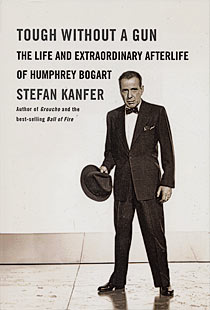Tough Without a Gun: The Life and Extraordinary Afterlife of Humphrey Bogart
By Stefan Kanfer
Share
 Most movie stars are forgotten while they’re still making movies. Humphrey Bogart somehow managed to get more famous after he died. This new biography doesn’t end with Bogart’s death from cancer in 1957, but goes on to tell us about the cult that grew up afterwards. His popularity spans generations and continents, with young and old, American and French, coming to see “the man in the trench coat as their beau ideal: mature, elusive—cool.” Even today, when interest in classic cinema is fading, Kanfer notes that “scholars, historians, fans, and total strangers” remain “unable to let go of Humphrey Bogart.”
Most movie stars are forgotten while they’re still making movies. Humphrey Bogart somehow managed to get more famous after he died. This new biography doesn’t end with Bogart’s death from cancer in 1957, but goes on to tell us about the cult that grew up afterwards. His popularity spans generations and continents, with young and old, American and French, coming to see “the man in the trench coat as their beau ideal: mature, elusive—cool.” Even today, when interest in classic cinema is fading, Kanfer notes that “scholars, historians, fans, and total strangers” remain “unable to let go of Humphrey Bogart.”
Before Bogart dies, though, the book seems rushed. Kanfer hits the key points in Bogart’s rise from disaffected well-to-do slacker to the most improbable leading man of the ’40s, but at under 300 pages, he can’t spend a lot of time on any of them. There are insightful bits of analysis here and there, particularly the difference between the WASP Bogart and the more “ethnic” movie tough guys who preceded him. Too often it seems like a Coles Notes version of a spectacular career; a movie as famous as Angels With Dirty Faces is passed over with a one-line reference to Bogart’s role as “a scheming bootlegger.”
Kanfer doesn’t offer an in-depth study of Bogart, but a primer as to why he still matters. He argues that there will never be another Bogart because in Bogie’s time, “demographics were irrelevant.” In the youth-dominated era of Justin Bieber, a manly middle-aged man with a cigarette could never become a star. The book turns out to be Kanfer’s lament for the good old days “of individuals uncomfortable with compromise and conformity.” Whether you believe that’s true or not, it does offer a clue as to why Bogart still sells: he reminds people of a supposedly better time when men were men. And when they wore trench coats.